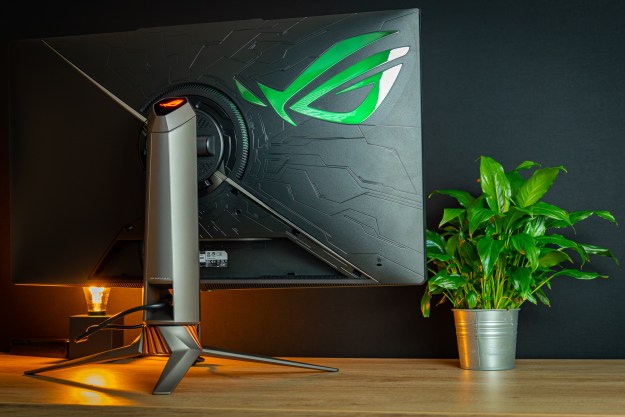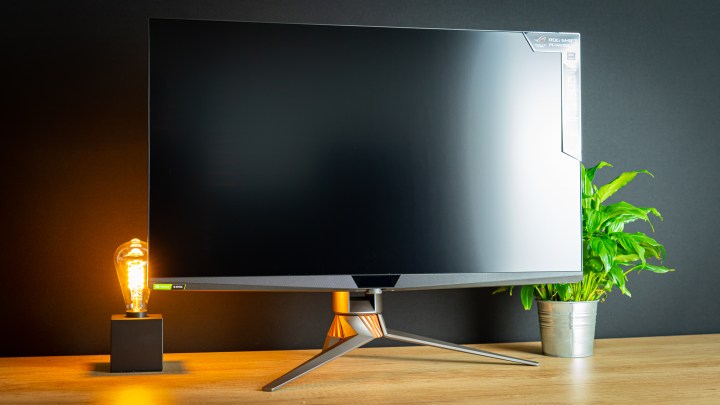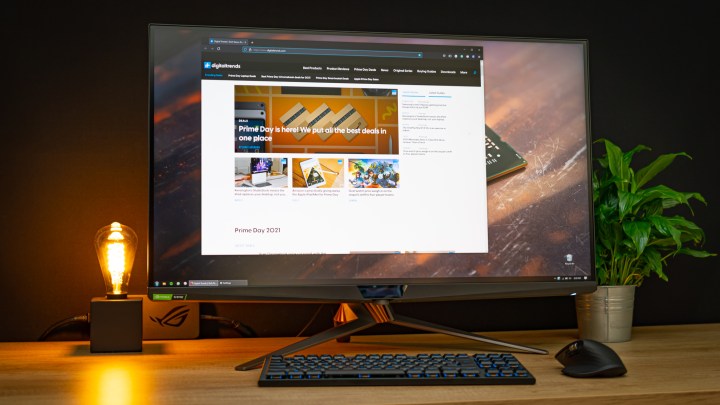
“The Asus ROG Swift PG32UQX is a brilliant piece of PC gaming gear, but its flaws are hard to swallow.”
- Mind-blowing HDR performance
- Extremely high peak brightness
- Excellent colors
- Thread built-in for camera mounting
- Fast, fluid gaming
- No HDMI 2.1
- Has audible cooling fan
- Still not a perfect HDR experience
- Expensive
The ROG Swift PG32UQX was first teased around two years ago, and it hyped up the PC gaming community unlike any gaming monitor in recent history. You’ll find forum threads full of excitement. And for good reason.
According to Asus, the ROG Swift PG32UQX featured mind-blowing HDR performance unlike any other monitor that’s currently on the market. More than that, it was also the first 32-inch 4K gaming monitor based on Mini-LED technology, featuring Full-Array Local Dimming (FALD) for
The catch, of course, was its price tag. $2,999 is more than most entire PC gaming setups cost, including PC, monitor, and peripherals. As such, it’s only realistic to expect absolute and utter perfection. The ROG Swift PG32UQX does a lot of things amazingly well, but perfect it is not.
Design

The ROG Swift PG32UQX is quite a large monitor. That’s expected from a 32-inch display, but the PG32UQX is a little bigger than most 32-inch panels due to its FALD illumination panel, which adds a noticeable thickness to the display.
The design style is also quite aggressive, with Asus sparing no opportunity for the PG32UQX to be recognized as a Republic of Gamers product. The monitor’s stand features the new-but-classic tripod design with a downward-cast illumination stamp, the back of the display has strong shapes and a huge, RGB-illuminated Asus ROG logo, and the display’s big chin has a little OLED panel in it for displaying entertaining visuals or system information, such as CPU temperature.

Indeed, there is a lot to take in here. But if you’re not into the styling, it’s easy enough to shove the back of the monitor towards a wall, replace the stand with a VESA mount, and then you’ll be left with just the display’s chin that may look a little aggressive.
The little OLED display is quite nifty though – I doubt anyone will mind it especially because it’s customizable.
The display’s power brick is external, which I suppose is a good thing as otherwise the PG32UQX would have been even bigger, and at the top of the monitor you’ll find thread to insert a camera mount – I tried, and this monitor will happily hold my
There is even a USB port at the top right next to it for plugging your webcam or camera into without having to feel around behind the monitor.
Ports and controls

The ROG Swift PG32UQX packs a wide host of connectivity options, but it’s not complete. There are three HDMI 2.0 ports, a single DisplayPort 1.4a port, a three-port USB hub, and a headphone out jack.
But indeed, HDMI 2.1 is missing, and that’s a big one.
There is a counter-side to that argument, and that is that there are still barely any PC monitors out with
The display’s OSD has slightly odd controls with a spinning wheel in the middle and a button to each side, but it is easy to navigate and most of the required settings are present.

However, in
There is a cooling fan
Before wrapping up, there is one more drawback that’s worth mentioning: the display has a cooling fan. It turns on the moment the display does, and while it isn’t loud, it is audible. This isn’t a problem if you use headphones or have silent music playing, but it may bug you if you enjoy a silent room and have an otherwise quiet computer.
Mini-LED and HDR
If there’s one reason you’re interested in buying the PG32UQX, it’s Mini-LED and its
LCD panels are unable to block out all of the light, even on black, meaning the ability to dim select areas (HDR on PC monitors, explained) is necessary to achieve full black levels. Dimming select areas also allows the display to increase peak brightness in a small area without over-illuminating the entire display. Most PC
However, as you can imagine, this illuminated column effect is undesirable, which is why manufacturers are experimenting with Mini-LED: an illumination technique that rather than edge-lighting the display, places an array with a huge number of individually controllable LEDs directly behind the panel. This illumination technique is called Full-Array Local Dimming (FALD), and in the PG32UQX’s case, that’s 1152 zones, offering lavishly fine local dimming control.
In a way, FALD actually fixes the major drawbacks of IPS panels: Backlight bleeding and IPS glow are no longer a problem because the afflicted area just isn’t illuminated when displaying black. The static contrast ratio isn’t as relevant either again, because the area simply wouldn’t be illuminated when displaying a black image.

Individual zones can peak at up to 1,400 nits of brightness when displaying highlights, and although I was unable to test this number due to my tester’s limitations, I’ll take Asus’ word on it: Bright lights, the sun, fires, and other highlights really popped off the screen in almost eye-searing brightness, which was really a sight to behold when just to the left of said object an area would be fully dark, displaying an inky-black night sky.
This kind of realistic luminosity control is exactly what
Fire up a game that does
But the technology isn’t perfect. The IPS panel is only capable of blocking so much light, and although 1,152 zones is magnitudes superior over an edge-lit display with 8 zones (which barely feels like
However, desktop use isn’t really a fair test, as individual elements are often far too small for the zones. It doesn’t address the higher peak brightness levels, and Microsoft’s
Fire up a game that does
Image quality
Thanks to its IPS panel, the PG32UQX has great color performance, which paired with the
We tested the monitor in SDR mode as our tester doesn’t do
With the clamp off, the panel covered a tidy 100% of the AdobeRGB and 97% of the DCI-P3 color spaces, with color accuracy rated at a Delta-E (difference from real) of 1.77. Any Delta-E under 2 is considered good enough for professional work. Calibrating the display did not yield any significant improvements, but its performance is plenty good out of the box.
Gamma performance was also perfect, though I was unimpressed with the panel’s native static contrast ratio. Whereas IPS panels, especially flat samples generally pin a result of about 1000:1, the best recorded contrast ratio I achieved in testing this sample was 810:1, which is what I would expect from a curved IPS panel that bleeds a little more due to the pressure. But this is a flat panel.

That being said, this was tested without
This raises the question of how much it really matters that the panel’s contrast performance isn’t great, which is a difficult question to answer. On the one hand, it shouldn’t matter with this kind of backlighting, but a panel with better static contrast performance would do a better job at blocking light, and thus do a better job at combatting the haloing exhibited by the PG32UQX.
Do keep in mind that contrast performance is something that varies greatly from sample to sample, and given that I feel this sample performed at the bottom end of the spectrum with other reports stating much higher contrast ratios, chances are you’ll have better luck.
What about OLED as an alternative?
If you’re looking for the perfect
The attraction would be that each pixel is its own light source. One pixel could be lit at peak brightness, and those directly adjacent to it pitch black. No halo-ing, just pure and perfect luminosity control across the panel.
But, there are a few catches. First and foremost, there are no OLED PC gaming
At the end of the day, the choice between Mini-LED and OLED is one of concessions: Which will you be able to tolerate, and which will you not. But if you’re asking yourself whether you should get the PG32UQX or an OLED TV for content consumption, then the PG32UQX is probably not for you – an OLED TV might not last as long, but it costs less than half as much – and I’ll bet that the PG32UQX will depreciate faster than an OLED will reach $0 in value.
Our take
The Asus ROG Swift PG32UQX is an amazing piece of equipment. With an array featuring 1,152 Mini-LED illumination zones, it produces an
The PG32UQX is at the cusp of what PC monitor technology can do nowadays, and if you’re after an
Are there any alternatives?
No. There are currently no other PC
How long will it last?
From a functional perspective, I see no reason why the ROG Swift PG32UQX couldn’t last a minimum of five years. But between the lack of
Should I buy it?
For most gamers, no. It has a few flaws that are guaranteed to be dealbreakers for large groups of buyers, especially at this price.
If you have deep pockets, and just want the best
Editors' Recommendations
- Meta Quest Pro vs. Quest 2: a clear choice for VR gaming
- USB-C charging laptops: Here’s what you need to know
- The best desktop computers for 2023: Dell, HP, Apple, and more
- Apple’s XR headset could get one of the Mac’s best features
- The best VR headsets for 2023








